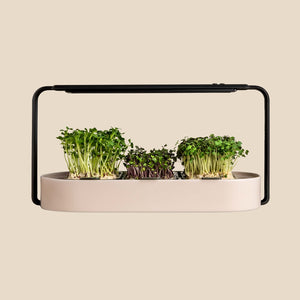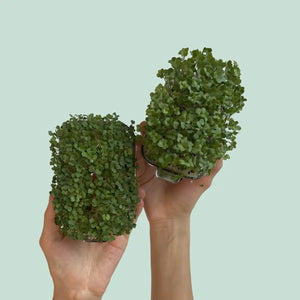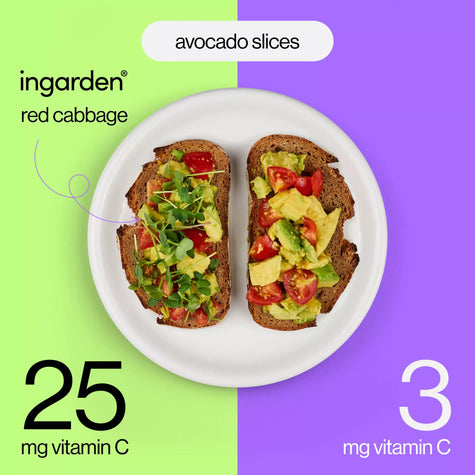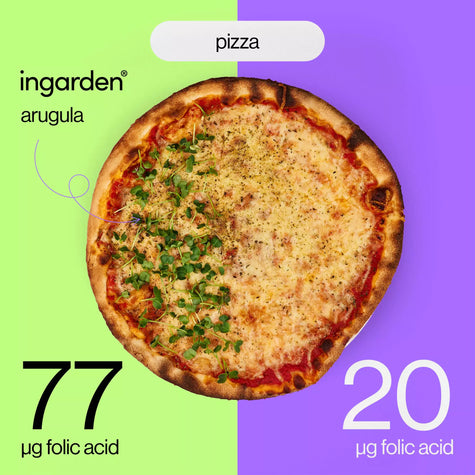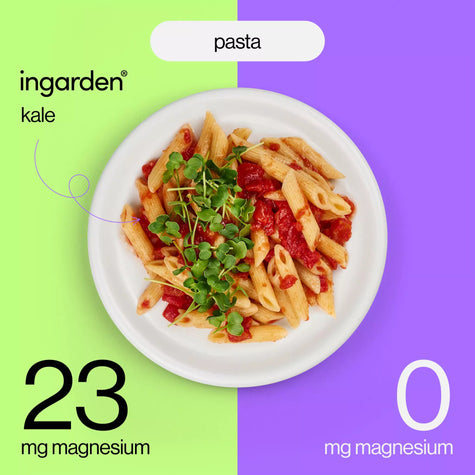Table of Contents
In the vibrant world of “superfoods you can grow at home”, two contenders stand out as nutritional powerhouses: microgreens and sprouts. As we embark on this journey, we'll delve into the nuances of these miniature greens, understanding their germination, growth, and the wealth of health benefits they bring to your plate. Choosing between microgreens and sprouts is not just a culinary decision; it's a lifestyle choice that can elevate your well-being.
Germination Process

Sprouts and microgreens share a common origin—the germination process. Understanding how each type begins its life journey provides insight into the nutritional richness they offer.
Sprouts:
Sprouts begin their journey by activating the dormant seed embryo during germination. This essential process not only starts the growth but also prepares for a release of nutrients. Seeds, previously inactive and lacking physiological activity, become alive, unlocking a series of vital compounds. The revitalized seed embryo paves the way for the subsequent development of sprouts.
Microgreens:
In the domain of microgreens, the process varies slightly. These small plants emerge from seeds and are harvested shortly after the cotyledons appear but before true leaves develop. This careful timing captures the essence of their immaturity, ensuring a distinct flavor profile and a concentration of nutrients. Microgreens showcase the potential within the seed, offering a vibrant snapshot of a plant's early life.
Harvesting and Size
Sprouts:
Sprouts, the swift growers of the green world, typically reach their peak at four to six days post-germination. This brief yet impactful period provides an appropriate size for harvest, making them manageable for post-harvest handling and commercialization. Their delicate nature and concentrated nutritional content make them a sought-after addition to various culinary creations. As they are often grown in water it is vital to wash the seeds once or twice a day to avoid mold. That's also the reason why it is recommended to cook sprouts before consuming them as they could contain bacteria from growing in a moist environment.
Microgreens:
Microgreens, on the other hand, require a bit more patience. Harvested between 7 to 21 days after germination, they showcase a length ranging from 5 to 10 cm. This carefully timed harvest captures the sweet spot after cotyledons emerge but before true leaves develop. The resulting size ensures not only a burst of flavor but also a visual spectacle of vibrant colors that elevate the aesthetics of your dishes.
Storage and Shelf Life
Understanding the differences in storage conditions and shelf life ensures that you get the most out of your sprouts and/or microgreens.
Sprouts
Sprouts, with their heartier constitution, boast a longer shelf life compared to their microgreen counterparts. Properly stored in refrigeration, sprouts can maintain their freshness for an extended period. This characteristic makes them a convenient choice for those who prefer to purchase in larger quantities or wish to incorporate greens into their meals over several days.
Microgreens
Microgreens, however, demand a more immediate usage. Swift deterioration after harvest is the nature of these delicate greens. When stored at room temperature, microgreens can be safely consumed within 1 to 2 days. A more convenient method would be to only harvest the greens that you actually use and let the rest remain in its growing medium before you continue harvesting. That way the stay fresh for a longer time.
Understanding the shelf life nuances of sprouts and microgreens guides your approach to incorporating them into your culinary repertoire.
Nutrient Values
The heart of the matter lies in the nutrient richness of sprouts and microgreens. Each green variety boasts a unique set of phytochemicals, offering a palette of health benefits. Let's dissect the intricate details of amino acids, pectins, ash, sugar, organic acids, soluble solids, dry matter, and pH, unlocking the comprehensive nutritional profiles that define these tiny greens.
Sprouts
Sprouts are recognized for their high phytochemical content. This includes a variety of flavonoids, hydroxycinnamic acids, vitamins, glucosinolates, minerals, and carotenoids. The germination process infuses sprouts with a concentrated burst of these bioactive compounds, making them not only a flavorful addition to meals but also a source of essential nutrients that contribute to overall well-being.
- Amino Acids: Sprouts emerge as a rich source of amino acids, the building blocks of proteins. This makes them an excellent addition to plant-based diets, contributing essential proteins for overall health.
- Pectins: The presence of pectins in sprouts adds a soluble fiber component, aiding in digestion and supporting heart health.
- Sugars: While sprouts contain sugars, their low calorific value and high nutrient content make them a wholesome choice for those conscious of their sugar intake.
- Organic Acids: The inclusion of organic acids contributes to the refreshing taste of sprouts, enhancing their culinary appeal.
That said, sprouts are less nutritious than microgreens with less fiber content, too. Raw sprouts can also be riskier to eat.
Microgreens
Microgreens, on the other hand, present a different nutritional profile. They are known for their high levels of carotenoids, chlorophylls, and organic acids. These vibrant compounds not only contribute to the visual appeal of microgreens but also offer distinct health benefits. The combination of colors and bioactive compounds makes microgreens a flavorful and nutritious addition to salads, sandwiches, and various culinary creations.
-
Carotenoids, Chlorophylls, and Organic Acids: Microgreens shine in their high levels of carotenoids, chlorophylls, and organic acids. These compounds contribute to their vibrant colors, fresh taste, and potential health benefits.
-
Sugar and Soluble Solids: Microgreens showcase a balance of sugars and soluble solids, offering a delightful sweetness that pairs well with various dishes.
-
Dry Matter and pH: The dry matter content and pH levels of microgreens contribute to their overall texture and taste, providing a diverse culinary experience.
Understanding the intricate nutritional values of sprouts and microgreens enables you to tailor your dietary choices to align with your health goals.
Health Benefits and Usage
The reputation of sprouts and microgreens as wellness-promoting foods precedes them. Let's uncover the health benefits they bring to the table and explore the myriad ways in which they can be seamlessly integrated into your daily culinary ventures.
Sprouts:
Sprouts have long been hailed as nutritional powerhouses, earning recognition for their high content of essential nutrients and bioactive compounds. Packed with flavonoids, hydroxycinnamic acids, vitamins, glucosinolates, minerals, and carotenoids, sprouts contribute significantly to overall health. Dietitians often recommend sprouts for their potential role in protecting the body against chronic disorders such as cardiovascular diseases, diabetes, and cancer. The low calorific value and low glycemic index further enhance their appeal as wellness-promoting foods.
However, due to its difficult germination process and higher chances of contamination with bacteria and mold, sprouts should not be consumed if you have a weak immune system or other medical conditions. Please consult your primary care doctor if you are unsure about growing sprouts at home. It is also recommended to cook them before consumption.
Microgreens:
Microgreens, though relatively newer on the scene, have quickly gained popularity for their health benefits. High levels of carotenoids, chlorophylls, and organic acids contribute to their nutritional profile. Studies suggest that microgreens exhibit higher anti-diabetic and anti-cholinergic activity compared to sprouts, adding an extra layer of health-promoting potential. The delicate texture, unique colors, and high palatability of microgreens make them not just nutritious but also a joy to include in your daily meals.
Antioxidant Capacity and Biological Activity

Beyond the realm of flavor, sprouts and microgreens emerge as potent sources of antioxidants, contributing to their biological activity. Let's delve into the science behind their antioxidant capacity and explore the roles they play in promoting overall health.
Sprouts:
Sprouts stand out for their robust antioxidant capacity, attributed to their high polyphenol and L-ascorbic acid content. These antioxidants play a crucial role in neutralizing free radicals in the body, potentially preventing oxidative stress. The polyphenols and L-ascorbic acid found in sprouts contribute not only to their freshness but also to their ability to support the body's defenses against chronic disorders. This antioxidant prowess adds an extra layer of health benefits to the already nutrient-rich profile of sprouts.
Microgreens:
Microgreens, too, exhibit notable antioxidant capacity, thanks to their rich content of carotenoids, chlorophylls, and organic acids. These compounds contribute to the vibrant colors of microgreens and play a crucial role in promoting overall health. Studies suggest that microgreens showcase higher anti-diabetic and anti-cholinergic activity compared to sprouts, further establishing their status as health-promoting warriors. As you incorporate microgreens into your dishes, you're not just adding flavor; you're infusing your meals with a dose of antioxidants that may contribute to long-term well-being.
Caloric Value and Glycemic Index
Low Caloric
Both sprouts and microgreens share a common ground when it comes to caloric content. With a low calorific value ranging from 29 to 128 kcal per 100 grams, these greens offer a guilt-free addition to your meals. This low caloric harmony aligns with the preferences of those seeking nutrient-dense options without compromising on flavor.
Low Glycemic Index
The glycemic index (GI) measures how quickly a food raises blood sugar levels. In the case of sprouts and microgreens, their low glycemic index makes them suitable for individuals mindful of their blood sugar levels. This characteristic ensures a steady release of energy without causing rapid spikes and crashes, making these greens an excellent choice for those following a balanced and health-conscious diet.
Species and Seeds

Let's explore the wide array of choices available for cultivating these tiny greens.
Sprouts:
Sprouts boast versatility in their choice of seeds, encompassing a wide variety of species. From cereals like lentils and soybeans to crucifers such as broccoli and radish, the selection is vast. The germination rate, taste, and chemical composition vary based on the chosen seed. This diversity in seeds allows you to tailor your sprouting experience, experimenting with different flavors and nutritional profiles.
Microgreens:
Microgreens, too, open up a world of possibilities in terms of species and seeds. Cereals, legumes, oilseeds, and crucifers—choices abound. Whether you opt for the nutty taste of sunflower, the peppery kick of radish, or the freshness of alfalfa, each seed brings its unique characteristics to the microgreen palette. This diversity ensures that your indoor garden can be a canvas for culinary creativity, offering a spectrum of flavors to elevate your dishes.
Culinary Use and Market Presence

Sprouts and microgreens aren't just confined to the realm of health; they've become innovative culinary ingredients, revolutionizing the way we approach food.
Sprouts:
Sprouts have seamlessly woven themselves into the fabric of culinary creations. From sandwiches and salads to soups, desserts, and beverages, sprouts add a delightful crunch and a burst of freshness. Their popularity in the culinary industry stems from their delicate texture, unique colors, and high palatability. The Japanese market, in particular, has embraced sprouts in various forms, from powders to additives in alcohols, juices, and teas. Available year-round, sprouts bring a touch of freshness even during winter, when the availability of fresh fruits and vegetables may be limited.
Microgreens:
Microgreens, with their vibrant colors and concentrated flavors, have become sought-after additions to culinary masterpieces. The innovative use of microgreens extends to sandwiches, salads, soups, desserts, and beverages, adding not only visual appeal but also a nuanced taste. Their delicate texture makes them particularly popular in fine dining establishments where chefs leverage their unique qualities to elevate the dining experience. As the market for functional foods grows, microgreens continue to gain traction, offering a blend of health benefits and culinary artistry.
Recommendations
Sprouts:
- Broccoli Sprouts: Packed with sulforaphane, a potent antioxidant, broccoli sprouts contribute to overall cellular health and may have anti-inflammatory properties.
- Radish Sprouts: Rich in vitamins and minerals, radish sprouts bring a peppery kick to your dishes, elevating flavor while providing essential nutrients.
- Lentil Sprouts: A source of plant-based protein, lentil sprouts offer a wholesome addition to vegetarian and vegan diets.
- Radish Microgreens: Known for their anti-diabetic and anti-cholinergic activity, radish microgreens add a burst of color and health benefits to salads and sandwiches.
- Amaranths Microgreens: With high levels of carotenoids and chlorophylls, amaranths microgreens contribute not only to visual appeal but also potential antioxidant benefits.
- Kale Microgreens: A nutrient powerhouse, kale microgreens offer a dense concentration of vitamins and minerals, supporting overall health.
To sum up, both sprouts and microgreens provide interesting flavors and health benefits, to your meals.Cheers to a greener, healthier tomorrow!
| Microgreens | Sprouts |
| Harvest within 1-3 weeks | Harvest within 3-6 days |
| Require soil/other growing medium, water, light and good air ventilation. | Grown in water - requires washing of seeds twice a day to avoid mold & bacteria growth. |
| Lower risk of mold & bacteria | Higher risk of mold & bacteria growth due to germination in moist environments like a sprouting glass |
| Higher level of nutrient and fiber | Lower level of nutrient and fiber |
| Higher anti-diabetic and anti cholinergic activity |
High polyphenol and L-absorbic acid content
|



